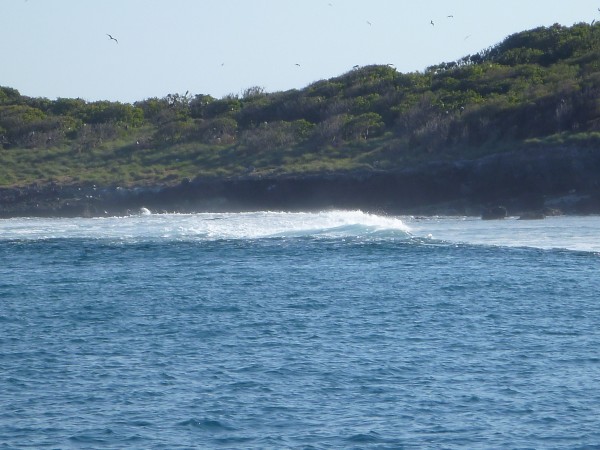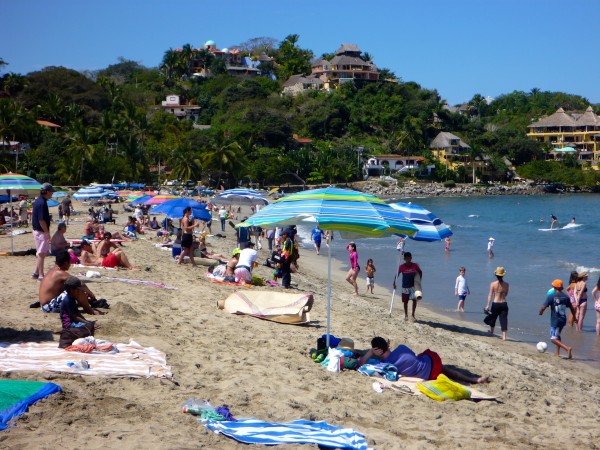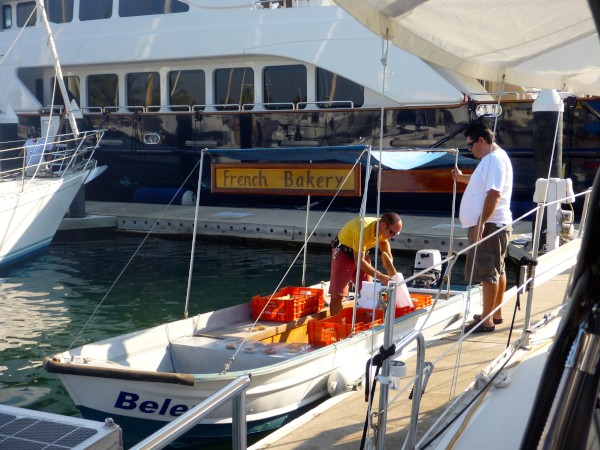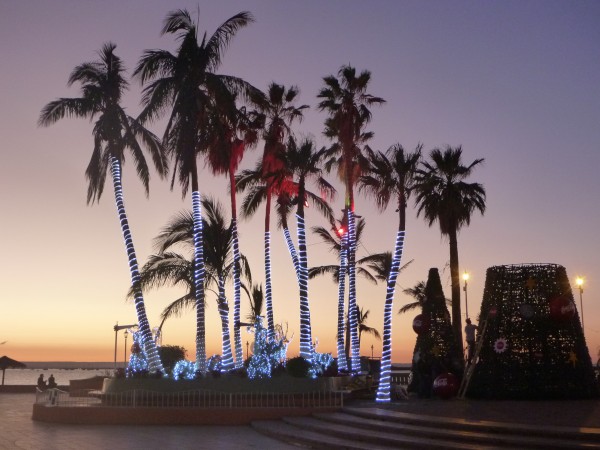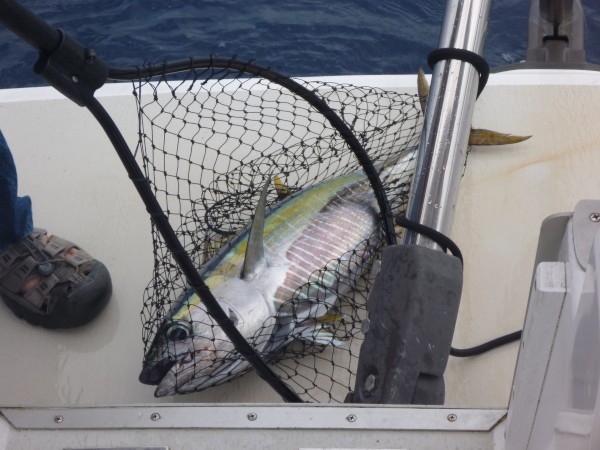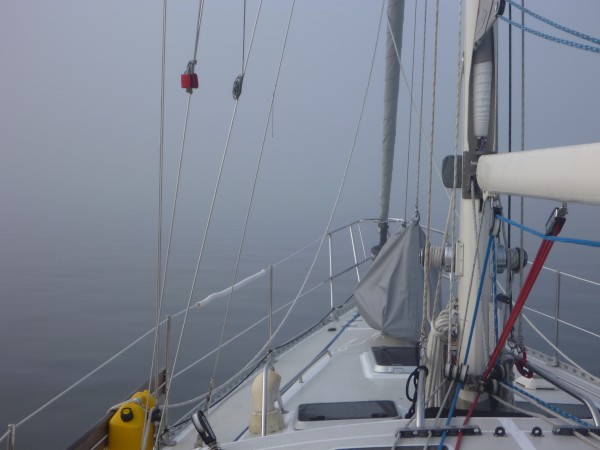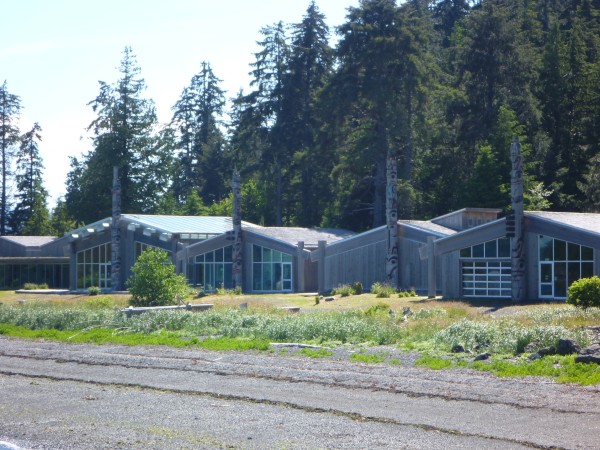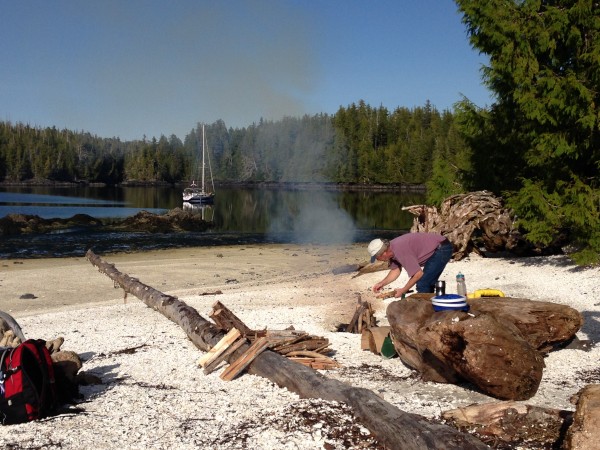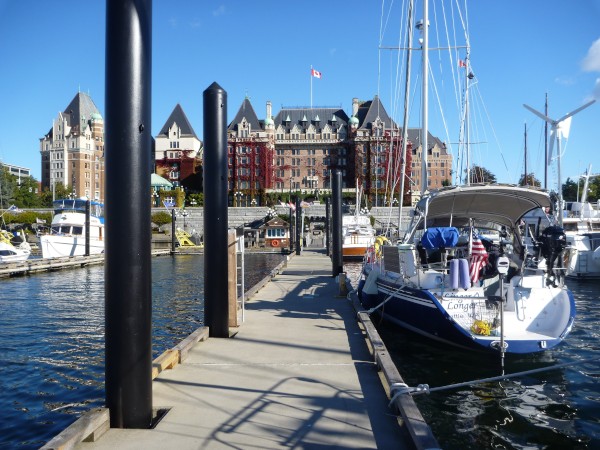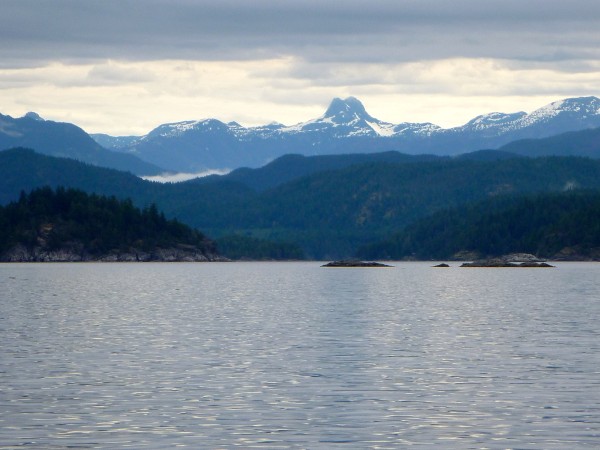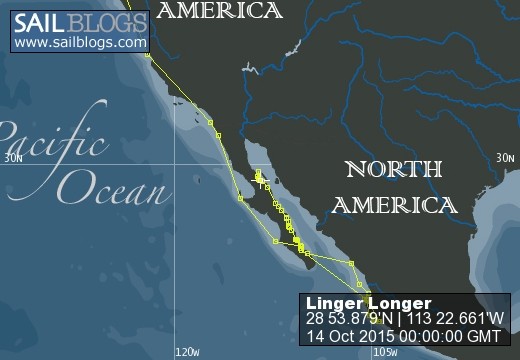
Linger Longer
14 September 2016
06 August 2016
09 July 2016
19 March 2016
19 December 2015
18 December 2015
18 December 2015
03 November 2015
18 July 2015
24 May 2015
04 April 2015
31 March 2015
26 February 2015
15 February 2015 | Barra de Navidad
07 February 2015 | Tenacatita Bay
04 February 2015
26 January 2015 | 19 18.051'N
04 January 2015 | La Cruz, Nayarit, Mexico
25 December 2014 | La Paz, Baja California Sur, Mexico
01 December 2014 | Ensenada, Mexico
Reflections by Kirk 6-17-2014
17 June 2014
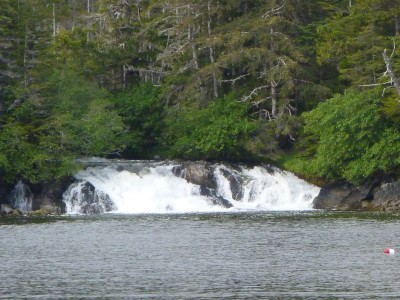
(Photo-Small waterfall at Porcupine Cove, outer coast near Lisianski Strait)
As you may have read previously, the ice and mountain setting of Glacier Bay National Park was really awesome. The next leg of our trip takes us toward and into the mighty Gulf of Alaska, spawning ground of the massive low-pressure weather systems, which bring destructive winds and rain to the Pacific coast from Alaska to Oregon. Upon leaving the National Park boundaries, we motored across Icy Strait with a favorable current, calm winds, and sunny skies; destination Elfin Cove, a place I needed to visit just because of the name. Visions of small elegant people in a fairyland setting danced through my head. Well, my dreamy visions were partly justified. The people were quite normal, maybe a little more laid back and friendly than normal, and decidedly not elegant. Most people were dressed in typical southeast Alaska fishing village attire. This may need some explanation. Most all of southeast Alaska is classified as temperate rainforest. This means relatively moderate temperatures and lots of rain throughout the year. It is amazing to Kris and me that for such a rainy place so few people wear raincoats. Hoodies, usually a dark color is standard attire. You can differentiate between men and women as men usually have a baseball cap under the hood. If it is much more than a heavy drizzle, a coat, think Carhart, is worn over the hoodie. Jeans, canvas pants or Carhart coveralls are the norm for below the waist coverings. Footwear is where southeast Alaskans stand out. Sitka sneakers, Ketchikan Keds, Petersberg pumps or choose your own creative name for each city, they all refer to the ubiquitous Xtra-Tuf rubber boots. I think almost more than anything else these boots have come to symbolize southeast Alaska to us. The brown rubber calf high boots are everyday footwear for young and old for all occasions from work to dinner out. Since many Seattle commercial fishermen have worked in Alaskan waters, the popularity of XtraTufs has worked its way south. I purchased a pair in Seattle at a marine chandlery that caters to commercial fishermen and I understand the reasons for the popularity. They are surprisingly lightweight, flexible and comfortable.
So the people of Elfin Cove are pretty near normal and not the small elegant folks of my fantasy vision. The setting of this village is a different story. We were tied at the end of the transient float in the outer harbor. The skies were clear and our view north across Icy Strait was special. Clear skies here are different than what we normally see in the suburban areas where most of my life has been lived. There is no industry within sixty miles and no cars within twenty miles. The sky is a color blue that you can only see in the absence of air pollution. The clarity with which one can see things at great distances is remarkable. Anyway, twelve miles across Icy Strait lies the huge Brady Glacier, an expanse of flat mottled white ice. Beyond the glacier, about sixty miles away, the completely snow clad Fairweather mountain range glistened a brilliant white in the sunshine. The village itself is nestled between the hillside and water's edge. There are few flat spots so most of the village is built over the water on pilings with numerous boardwalks being the only way to get around. If you want to go from here to there, you walk. We saw no evidence of any kind of vehicle. No big deal as this is a very small village with a year round population of twenty five or thirty folks which swells to maybe two hundred in summer when a few fishing lodges open and summer residents move back into their homes. The place is well kept with an obvious sense of pride. In the summer a tiny, but well stocked general store, restaurant/bar, a few small shops and a laundromat are open for business along the boardwalks. Small boats come and go carrying lodge guests in search of halibut, salmon, rockfish, and lingcod. Small groups of people on benches or leaning against the boardwalk guardrails catch up on news and gossip. This really is an enchanting place that was not named for small elegant people, but for the name of an early settler's boat.
Our next stop was to Pelican, another boardwalk town named for a boat, but with a much different feel to it than Elfin Cove. Pelican has fallen on hard times. The fish processing plant has closed down. Just recently, the general store also closed. It is in a beautiful setting, but just has the feel of a place in serious decline. We saw too many for sale signs on homes along the boardwalk. The local restaurant/bar, Rosie's, claims to be world famous, but was shabby and rundown, also for sale. We were there during the annual Salmon Derby, supposedly one of Pelican's big events, but saw few signs of outsiders competing for the $2,500 first prize. Weather kept us there for a few days and we were relieved when we could finally leave.
We left Pelican with a weather forecast that called moderate winds, but six-foot seas. The plan was to travel Lisianski Strait through the narrow rock bound entrance out into the Gulf of Alaska. We felt comfortable about attempting the narrow passage in moderately high seas as there was the promise of an anchorage at Lost Cove just inside the entrance should we decide that conditions were a little too rough for us, and that's what happened. We turned around to seek safe shelter. We circled Lost Cove for about 45 minutes and could not find a spot that seemed right for anchoring, so decided to brave the rough seas for a spot that had more attributes of a good anchorage. We did get bounced around a bit, but made it out and around a large area of rocks, then into a beautiful spot called Porcupine Cove. It was well worth the effort and we had finally made it out into the Gulf of Alaska. Except for the small towns of Sitka and Craig, the outer coast of southeast Alaska is wild and mostly unpopulated. There was only a small thin strip of land separating us from the ocean swells of the North Pacific, but we were all alone in calm water as some tree swallows flew over to greet us. Once again we were skunked for fish and crabs, but that did not lessen our enjoyment of the place. The swallows seemed to have a special interest in our boat and kept landing often at less than an arms length away. We would talk to them and they would cock their heads as though listening and trying to understand. The next morning I watched unusual swallow activity at the bow of the boat. One of two swallows sat on the rail near me, obviously to distract me while the other was busy at the bow. The bird on the bow would hop and poke around on the deck before fluttering up to our headsail-furling unit. This is about a 12-inch diameter five-inch high metal enclosure with an opening in one side through which our furling line passes. We felt really bad when we dismantled the partially completed nest, which they had apparently spent several hours working on. They circled the boat at close quarters as we departed Porcupine Cove. Explanations that our furling unit was really not going to be a suitable home did not seem to help assuage their dismay.
The next few days included two fine anchorages, some time in the outside waters and some time in the "smooth water" route behind the protection of small islands and off lying rocks enroute to the historic town of Sitka. It seems that Sitka has interested me for a long time and particularly since reading James Michener's Alaska. In Michener's book the Sitka locale plays a major part. Tlingit natives enjoyed thousands of years in the protected waters of Sitka Sound. The ocean provided a bounty of food. The mountain and valley forests provided material to build large sturdy wooden homes, ocean going canoes, weapons, clothing, and more food. A rich culture and structured society developed.
Russians were the first white-skinned people to "discover" Alaska. They first landed in the Aleutian Islands. Subjugating native Aleut people to hunt the lucrative sea otters, they steadily worked eastward toward mainland Alaska. When the Russians finally reached southeast Alaska, home of the Tlingits, they ran into a fierce tribe who were protective of their land and trading rights. Battles went on for a few years, but the Russian cannons finally prevailed and the Tlingits moved away from their village in Sitka, but stayed in the area. Russians brought laws and religion. Many Tlingits adapted to Russian rule and an uneasy peace developed. Life was relatively good for all but the sea otters. Russia's burden of being involved in wars back in the more populated western part took a toll both in manpower and money. Alaska was very far away from the center of power and selling the Alaska territory seemed like a good way to raise some money. A deal was stuck with the United States. Russians, and for that matter most in the United States, believed that Russia got the better part of the deal. Time has proven that the United States, in purchasing the Alaska territory for about two cents per acre, turned "Seward's Folly" into one of the better buys in world history. Vestiges of the Russian presence remain in Sitka today. The Tlingits are still there.
Tourism and fishing seem to be the main revenue sources in Sitka. A few cruise ships a week visit in the summer. The airport has regularly scheduled jet airliner flights and ubiquitous seaplanes come and go all the time. Fishing goes year round. It is still a very beautiful area and Sitka is an attractive small town full of history and of friendly people.
We spent quite a bit of time in the Sheldon Jackson Museum, which is dedicated to the collection of native artifacts from all over Alaska. It was amazing to see how Native peoples used natural materials, skins, bones, wood, rock, grass, roots and all manner of materials to fashion that which was necessary for everyday living. Not just serviceable, but works of art. Sewing kits with carved bone to hold carved needles in patterned skin pouches. Wooden halibut hooks with elaborate fish carvings. Very beautiful clothing, some skin, some woven of animal hair with intricate designs and decorations of quills, feathers, fur, and whatever. Beautiful baskets made of grasses, roots or bark. Bentwood boxes are unique constructions. The four sides are made from one continuous piece of wood. The only joints in these elaborately carved and painted boxes are at the top, bottom and only one corner of the sides. Ceremonial bowls again with intricate carvings would have insets of abalone shell, animal teeth or colorful polished rock. We saw complete body covering waterproof suits made of dried and sewn fish skins. These flexible, lightweight waterproof suits would be worn over fur clothing by natives who ventured out into the cold and often stormy waters of the Bering Sea in skin sheathed kayaks called baidarkas to hunt sea mammals; otters, seals, sea lions and whales. Seeing the results of the industriousness, creativity and ingenuity of the native peoples was an illuminating experience. I could not but help imagine a man (or women) sitting on a beach log, using tools of his own creation to carve on a piece of wood. The smell of fresh carved wood, the feel of smoothed wood in the hands, the sounds of water on the beach, birdsong, branches rustling in the wind and the sights of eagles soaring ever upward, sea mammals cavorting in the water and the patterns of sunlight on the ocean water all give me the sense that these people were at peace within their environment. I contrast this with someone in a windowless room filled with conditioned air, staring at a flat screen of two-dimensional symbols with ear buds providing the only sounds. It gives me pause to wonder who is really the most civilized.
Kirk
As you may have read previously, the ice and mountain setting of Glacier Bay National Park was really awesome. The next leg of our trip takes us toward and into the mighty Gulf of Alaska, spawning ground of the massive low-pressure weather systems, which bring destructive winds and rain to the Pacific coast from Alaska to Oregon. Upon leaving the National Park boundaries, we motored across Icy Strait with a favorable current, calm winds, and sunny skies; destination Elfin Cove, a place I needed to visit just because of the name. Visions of small elegant people in a fairyland setting danced through my head. Well, my dreamy visions were partly justified. The people were quite normal, maybe a little more laid back and friendly than normal, and decidedly not elegant. Most people were dressed in typical southeast Alaska fishing village attire. This may need some explanation. Most all of southeast Alaska is classified as temperate rainforest. This means relatively moderate temperatures and lots of rain throughout the year. It is amazing to Kris and me that for such a rainy place so few people wear raincoats. Hoodies, usually a dark color is standard attire. You can differentiate between men and women as men usually have a baseball cap under the hood. If it is much more than a heavy drizzle, a coat, think Carhart, is worn over the hoodie. Jeans, canvas pants or Carhart coveralls are the norm for below the waist coverings. Footwear is where southeast Alaskans stand out. Sitka sneakers, Ketchikan Keds, Petersberg pumps or choose your own creative name for each city, they all refer to the ubiquitous Xtra-Tuf rubber boots. I think almost more than anything else these boots have come to symbolize southeast Alaska to us. The brown rubber calf high boots are everyday footwear for young and old for all occasions from work to dinner out. Since many Seattle commercial fishermen have worked in Alaskan waters, the popularity of XtraTufs has worked its way south. I purchased a pair in Seattle at a marine chandlery that caters to commercial fishermen and I understand the reasons for the popularity. They are surprisingly lightweight, flexible and comfortable.
So the people of Elfin Cove are pretty near normal and not the small elegant folks of my fantasy vision. The setting of this village is a different story. We were tied at the end of the transient float in the outer harbor. The skies were clear and our view north across Icy Strait was special. Clear skies here are different than what we normally see in the suburban areas where most of my life has been lived. There is no industry within sixty miles and no cars within twenty miles. The sky is a color blue that you can only see in the absence of air pollution. The clarity with which one can see things at great distances is remarkable. Anyway, twelve miles across Icy Strait lies the huge Brady Glacier, an expanse of flat mottled white ice. Beyond the glacier, about sixty miles away, the completely snow clad Fairweather mountain range glistened a brilliant white in the sunshine. The village itself is nestled between the hillside and water's edge. There are few flat spots so most of the village is built over the water on pilings with numerous boardwalks being the only way to get around. If you want to go from here to there, you walk. We saw no evidence of any kind of vehicle. No big deal as this is a very small village with a year round population of twenty five or thirty folks which swells to maybe two hundred in summer when a few fishing lodges open and summer residents move back into their homes. The place is well kept with an obvious sense of pride. In the summer a tiny, but well stocked general store, restaurant/bar, a few small shops and a laundromat are open for business along the boardwalks. Small boats come and go carrying lodge guests in search of halibut, salmon, rockfish, and lingcod. Small groups of people on benches or leaning against the boardwalk guardrails catch up on news and gossip. This really is an enchanting place that was not named for small elegant people, but for the name of an early settler's boat.
Our next stop was to Pelican, another boardwalk town named for a boat, but with a much different feel to it than Elfin Cove. Pelican has fallen on hard times. The fish processing plant has closed down. Just recently, the general store also closed. It is in a beautiful setting, but just has the feel of a place in serious decline. We saw too many for sale signs on homes along the boardwalk. The local restaurant/bar, Rosie's, claims to be world famous, but was shabby and rundown, also for sale. We were there during the annual Salmon Derby, supposedly one of Pelican's big events, but saw few signs of outsiders competing for the $2,500 first prize. Weather kept us there for a few days and we were relieved when we could finally leave.
We left Pelican with a weather forecast that called moderate winds, but six-foot seas. The plan was to travel Lisianski Strait through the narrow rock bound entrance out into the Gulf of Alaska. We felt comfortable about attempting the narrow passage in moderately high seas as there was the promise of an anchorage at Lost Cove just inside the entrance should we decide that conditions were a little too rough for us, and that's what happened. We turned around to seek safe shelter. We circled Lost Cove for about 45 minutes and could not find a spot that seemed right for anchoring, so decided to brave the rough seas for a spot that had more attributes of a good anchorage. We did get bounced around a bit, but made it out and around a large area of rocks, then into a beautiful spot called Porcupine Cove. It was well worth the effort and we had finally made it out into the Gulf of Alaska. Except for the small towns of Sitka and Craig, the outer coast of southeast Alaska is wild and mostly unpopulated. There was only a small thin strip of land separating us from the ocean swells of the North Pacific, but we were all alone in calm water as some tree swallows flew over to greet us. Once again we were skunked for fish and crabs, but that did not lessen our enjoyment of the place. The swallows seemed to have a special interest in our boat and kept landing often at less than an arms length away. We would talk to them and they would cock their heads as though listening and trying to understand. The next morning I watched unusual swallow activity at the bow of the boat. One of two swallows sat on the rail near me, obviously to distract me while the other was busy at the bow. The bird on the bow would hop and poke around on the deck before fluttering up to our headsail-furling unit. This is about a 12-inch diameter five-inch high metal enclosure with an opening in one side through which our furling line passes. We felt really bad when we dismantled the partially completed nest, which they had apparently spent several hours working on. They circled the boat at close quarters as we departed Porcupine Cove. Explanations that our furling unit was really not going to be a suitable home did not seem to help assuage their dismay.
The next few days included two fine anchorages, some time in the outside waters and some time in the "smooth water" route behind the protection of small islands and off lying rocks enroute to the historic town of Sitka. It seems that Sitka has interested me for a long time and particularly since reading James Michener's Alaska. In Michener's book the Sitka locale plays a major part. Tlingit natives enjoyed thousands of years in the protected waters of Sitka Sound. The ocean provided a bounty of food. The mountain and valley forests provided material to build large sturdy wooden homes, ocean going canoes, weapons, clothing, and more food. A rich culture and structured society developed.
Russians were the first white-skinned people to "discover" Alaska. They first landed in the Aleutian Islands. Subjugating native Aleut people to hunt the lucrative sea otters, they steadily worked eastward toward mainland Alaska. When the Russians finally reached southeast Alaska, home of the Tlingits, they ran into a fierce tribe who were protective of their land and trading rights. Battles went on for a few years, but the Russian cannons finally prevailed and the Tlingits moved away from their village in Sitka, but stayed in the area. Russians brought laws and religion. Many Tlingits adapted to Russian rule and an uneasy peace developed. Life was relatively good for all but the sea otters. Russia's burden of being involved in wars back in the more populated western part took a toll both in manpower and money. Alaska was very far away from the center of power and selling the Alaska territory seemed like a good way to raise some money. A deal was stuck with the United States. Russians, and for that matter most in the United States, believed that Russia got the better part of the deal. Time has proven that the United States, in purchasing the Alaska territory for about two cents per acre, turned "Seward's Folly" into one of the better buys in world history. Vestiges of the Russian presence remain in Sitka today. The Tlingits are still there.
Tourism and fishing seem to be the main revenue sources in Sitka. A few cruise ships a week visit in the summer. The airport has regularly scheduled jet airliner flights and ubiquitous seaplanes come and go all the time. Fishing goes year round. It is still a very beautiful area and Sitka is an attractive small town full of history and of friendly people.
We spent quite a bit of time in the Sheldon Jackson Museum, which is dedicated to the collection of native artifacts from all over Alaska. It was amazing to see how Native peoples used natural materials, skins, bones, wood, rock, grass, roots and all manner of materials to fashion that which was necessary for everyday living. Not just serviceable, but works of art. Sewing kits with carved bone to hold carved needles in patterned skin pouches. Wooden halibut hooks with elaborate fish carvings. Very beautiful clothing, some skin, some woven of animal hair with intricate designs and decorations of quills, feathers, fur, and whatever. Beautiful baskets made of grasses, roots or bark. Bentwood boxes are unique constructions. The four sides are made from one continuous piece of wood. The only joints in these elaborately carved and painted boxes are at the top, bottom and only one corner of the sides. Ceremonial bowls again with intricate carvings would have insets of abalone shell, animal teeth or colorful polished rock. We saw complete body covering waterproof suits made of dried and sewn fish skins. These flexible, lightweight waterproof suits would be worn over fur clothing by natives who ventured out into the cold and often stormy waters of the Bering Sea in skin sheathed kayaks called baidarkas to hunt sea mammals; otters, seals, sea lions and whales. Seeing the results of the industriousness, creativity and ingenuity of the native peoples was an illuminating experience. I could not but help imagine a man (or women) sitting on a beach log, using tools of his own creation to carve on a piece of wood. The smell of fresh carved wood, the feel of smoothed wood in the hands, the sounds of water on the beach, birdsong, branches rustling in the wind and the sights of eagles soaring ever upward, sea mammals cavorting in the water and the patterns of sunlight on the ocean water all give me the sense that these people were at peace within their environment. I contrast this with someone in a windowless room filled with conditioned air, staring at a flat screen of two-dimensional symbols with ear buds providing the only sounds. It gives me pause to wonder who is really the most civilized.
Kirk
Comments
| Vessel Name: | S/V Linger Longer |
| Vessel Make/Model: | Sceptre 41/43 |
| Hailing Port: | Seattle, WA |
| Crew: | Kirk & Kristin Doyle |
| Extra: | |
| Home Page: | http://www.k2doyle.com |
S/V Linger Longer's Photos - Main
|
Heading north into the Sea of Cortez for the summer where there is less change of hurricanes.
72 Photos
Created 19 December 2015
|
Who: Kirk & Kristin Doyle
Port: Seattle, WA
